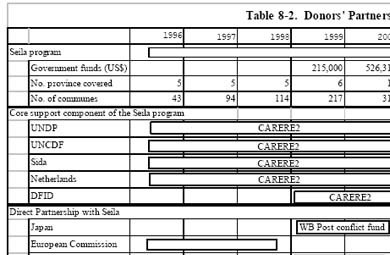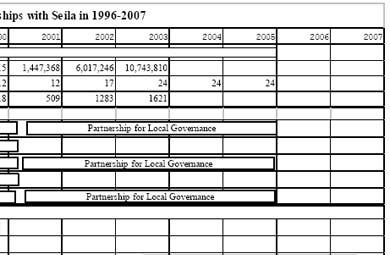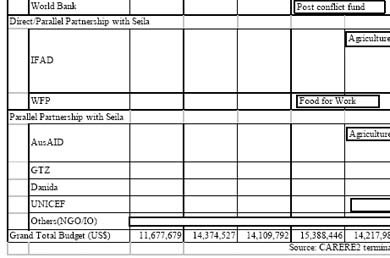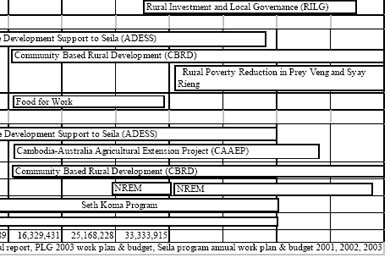 |
 |
 |
 |
||
|
|
 |
 |
 |
 |
||
|
|
|
1. Historical background and trends in donor assistance Historical background Decentralization in Cambodia has gained momentum since the formation of a new government in November 1998. It has been carried out as an integral part of the broader state reforms stipulated in the Governance Action Plan.51 The Commune/Sangkat Administration Law and Commune Election Law were promulgated to govern the administration and elections of the Communes/Sangkats in January and March 2001, respectively. The National Committee to Support the Commune (NCSC), an inter-ministerial committee, was established in May 2001 to steer the decentralization process and the Department of Local Administration was established at the Ministry of Interior in July 2001. The first commune elections were held in February 2002 to establish Commune Councils, the first elected bodies at the sub-national level in Cambodia. The Seila program (hereinafter referred to as Seila), which officially started in 1996, is a national program aiming to achieve poverty reduction through local development and improved local governance. In this context, Seila has been taking initiatives to decentralize governance in Cambodia.53 It started pilot programs in five provinces supported by Cambodia Area rehabilitation and Regeneration Project (CARERE2).54 It then gradually expanded to cover 12 provinces by the end of 2000.55 A program evaluation of Seila conducted in March 2000 concluded that its impact had exceeded the levels originally expected.56 It was decided that Seila should extend its program period up to 2005, during which more provinces would be covered. With the election of Commune Councils in February 2002, the Government at national and provincial level assumed responsibility for supporting all the Councils in the country. In response, Seila increased its coverage from 12 to 17 provinces in 2002. At the National Seila Workshop held in August 2002, a Deputy Prime Minister endorsed the recommendation to ensure equitable support across all 24 provinces and requested the steering institution of Seila to mobilize the necessary resources for them. As a result, Seila expanded to cover all 1,621 communes and all provinces in the country in early 2003. Trends of donor assistance and coordination in the sector From its inception, Seila envisioned a comprehensive decentralized and deconcentrated management system within the government that could mobilize both domestic and external resources for local development and local governance. Seilaís vision has been realized over time. In 1996, Seila started with support from UNDP, the Netherlands, EU, Sweden and UNCDF (see Table 8-2 for donorsí partnerships with Seila in 1996-2007). By the end of 2000 it was able to receive support from more donors, i.e., the UK, Australia, the World Bank, UNHCR, the WFP and IFAD, through either CARERE2 or other arrangements.58 CARERE2 finished its mission in 2001, and a new program called Partnership for Local Governance (PLG) was developed with cost-sharing by UNDP, DFID and Sida using trust fund arrangements. The PLG has been providing core support to Seila since then. The Seila program developed a unique flexible mechanism to coordinate partnership with other donors, and this partnership framework has proved very effective for mobilizing substantial external resources and delivering services and infrastructure to the commune level. Attracted by that framework, many donors agreed to channel their resources through Seila. The amount of external resources mobilized through the Seila framework has nearly doubled from $12 million in 1996 to $23 million in 2003. In 2003, Seila receives support from PLG, IFAD, GTZ, AusAID, Danida, UNICEF, WFP and the World Bank (see Table 8-1 for current donors and program contents). Table 8-1. Donorsí Partnership with Seila in 2003
|
 |
 |
 |
 |
|
Program Activities Seilaís overall goal is to institute decentralized systems and strategies for poverty alleviation and good governance. Its objectives are59;
From the beginning, Seila has applied a learning-by-doing approach to develop a comprehensive decentralized framework for the delivery of services and infrastructure. This framework, which have been piloted and tested to make sure it works on the ground, consists of the following four systems:
Seila has developed two funds, the Commune/Sankat (C/S) Fund and the Provincial Investment Fund (PIF), financed by external grants and loans and annual national budget appropriations, to deliver services and infrastructure to communes and provinces, respectively. Seila has developed criteria for allocation of these funds, and standard procedures for procurement, disbursement, accounting and auditing of the project financed by these funds. Planning system Seila has developed a set of technically sound and participatory planning procedures for the preparation of five year development plans (commune development plan and provincial development plan), three year investment programs (commune investment program and provincial development and investment program), and annual working plans and budgets of commune councils and provinces. Management and capacity building system Seila has established a comprehensive management structure (see Chart 8-1), in which the roles and responsibilities of villages, communes, districts and provinces are clearly defined in managing local investment programs. Seila assists the provincial administration in providing support and supervision services for commune councils. Seilaís assistance includes planning facilitation, training and technical services. Monitoring and evaluation system Seila has developed: (1) the provincial level management information system that tracks the physical and financial progresses of all projects executed under Seila program and provides consolidated quarterly reports; (2) the commune database (including poverty index database) to support the poverty-based geographic targeting of the programís resources; and (3) a program to evaluate Seilaís efficiency and development impact. Seila has been applying the systems described above in all provinces and communes in the country since March 2003. A recent evaluation has concluded that the Seila systems at the provincial and commune levels have had a positive impact on local development.60 In addition, Seila has offered smooth and efficient disbursement of donorsí funds through the Seila framework. This proven track record of achieving results helped convince the government and donors to provide increased funds for Seila over time. Moreover, Seila offered the government a testing ground for regional and local planning and development, from which useful lessons have been drawn that the government has used to formulate decentralization and deconcentration policies and implement reform programs on local governance.61 In return, the government has provided strong backing for the program. 2. Mechanisms to manage aid coordination Institutional arrangements Seila is guided by the Seila Task Force (STF), consisting of the various ministries described in Chart 8-1.62 The STF Secretariat is responsible for executing the program and reporting to the STF. The STF Secretariat comprises seconded officials from various ministries, totaling 30 staff as of 2003. Each ministry participating in STF appoints a ministerial focal point to facilitate and assist STF work.
|
||||||||||||||||||
|
Administration Unit (CAU); (ii) Local Administration Unit (LAU); (iii) Finance Unit (FU); and (iv) Technical Support Unit (TSU). The LAU includes both province- and commune-level facilitation teams (PFT and DFT, respectively) of local planners and community development workers who directly support commune councils. The staff for ExComs and their management units above are seconded from various ministries as shown in Table 8-3. The establishment of PRDC, the ExCom and its management units in all provinces has been completed in 2003. The PLG provides advisory services to Seila in all areas, and is staffed by 6 international advisors and 170 local advisors. Coordination at the national level The Seila Forum was established in 2002 as an institution of Seila to promote effective government-donor partnership development. The purposes of the Seila Forum are the following: (i) developing a common vision of Seila; (ii) establishing mutual commitment (financial and otherwise) among partners; (iii) monitoring the programís financing requirements and financing strategy; (iv) reaching an operational consensus on Seila and management issues; (v) developing a common evaluation framework; and (vi) adopting a unified strategic performance reporting format. The members of the Seila Forum are the representatives of all donors supporting Seila, and the members of the STF. Donors who are considering joining the Seila funding framework are invited to attend the Forumís meetings. Coordination at the sub-national level District Integration Workshops (DIWs) play a critical coordination role at the sub-national level. They are held annually to integrate and coordinate the commune level investment plans. Commune councils, provincial departments, NGOs, donor agencies, and representatives of civil societies are invited to this workshop. The detailed guidelines issued by the Ministry of Planning describe how the district integration process is carried out (see Chart 8-2). Before the DIW, the priority activities identified by Commune Councils are compiled into a table (the District Priority Activities Matrix) and distributed to provincial departments, NGOs, and donor agencies in concerned provinces. The departments, NGOs, and donor agencies study the Commune Councilsí priorities for implementation, and compare them with known resources allocated through the PIF or available resources through specific programs. At the DIW, the Commune Councils present their priority activities, and the departments, NGOs and donor agencies present their services that they intend to provide. Temporary agreements are signed and recorded between the Commune Councils and the departments, NGOs and donor agencies that intend to offer support. After the DIW, the temporary agreements are followed up with the formulation of specific budgets, intended outputs and work plans. Chart 8-1 Seila Programís Organization Diagram
Chart 8-3 District Integration Process
Accepting a variety of fund flows has placed an extra burden on Seilaís financial management, such as the preparation of different agreements or separate reporting on disbursement for specific fund arrangements. However, this extra burden has been necessary, given the weak state of public financial management, in order for Seila to be able to deliver services and infrastructure to the commune level with reasonable speed and efficiency. Chart 8-4. Flow of PLG and National Funds through the Seila Program
Chart 8-5. Flow of ADESS funds for Agriculture Development through Seila
Process of aid coordination Seila consists of a core support component which a small group of donors support directly through a trust fund, and a supplemental component in which donors provide services through the Seila framework to provinces and communes in specific sectors, regions, or to specific target groups. As was mentioned, a variety of fund arrangements can be accommodated through the supplemental component. The STF Secretariat manages the funds directly (direct partnership) or line ministries, donors or NGOs manage them in collaboration with Seila (parallel partnership).
|
||||||||||||||||||